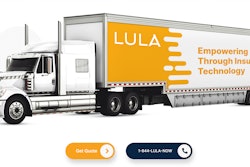When Progressive emailed me asking if I'd like to join the Snapshot program, which would integrate a mobile app or attach a plug-in device to my car's computer to try and save me money based on my driving habits, I declined. Insuring my 24 year-old Subaru in rural Southern Vermont cost just $43 a month. I didn't need any possible savings. Plus, this was my first stick-shift car, and I wanted to minimize the historical documentation of all the times I stalled out in intersections or gently bonked into a snow bank.
But what I didn't know, and what Overdrive's polling has proven many professional drivers don't know, either, is that Snapshot is part of an entirely new category of insurance that could potentially save small fleets and owner-operators thousands every year by limiting how much they pay for insurance according to the amount they actually drive and need it.
Progressive, Canal, and Great West Casualty all offer what's called "usage-based insurance," which use different mechanisms to bill based on miles driven, or in the case of insurance startup Lula, previously covered at the link, based on days of usage. Many of these plans promise significant savings on rising liability insurance costs for owner-ops, as well as the ability to pay variable rates month by month as opposed to all up front.

[Related: Pay-per-day insurance? Lula aims at trucking insurance niche]
Jeff Moseler, an account executive at Navigator Truck Insurance Agency, said that usage-based insurance has been around for a while, but few people even know how to take advantage of the potential savings. Moseler said that most insurers require a fleet to have at least 10 trucks for usage-based plans, but some newer plans on the market target smaller operations.
""Usage-based is referred to in the industry as 'composite rate' and there’s two different types," he said. "A standard composite rate and a reporting policy."
Here's how he broke down the first of those:
"Let’s say a company is going to pay $120,000 in premiums. In a composite rate they take the rate of $120,000 and say you’re gonna do 1.2 million miles, so we’ll divide it by the number of miles and say you pay 10 cents a mile and run 100,000 miles a month, so we’re going to bill you and at the end of the policy we audit it and refund you to a degree. They have what they call minimum premiums, usually 80% or 90%, so if you estimated 1.2 million miles and you actually ran 700,000," the company might be billed 900,000 for the full year.
According to Moseler, this type of insurance benefits any operator or fleet that can meet the minimum miles, but may have some downtime with trucks or drivers.
"To a trucking company, it makes more sense to them" if they run the risk of losing "a driver. or a truck goes down for maintenance" and ends up sitting , not generating revenue, he said. Naturally, risk is incurred "when the truck is driving and generating miles." If a truck is sitting under such a plan "you're not going to pay insurance on it."
The other model for usage-based insurance described by Moseler is a "reporting policy," wherein companies simply report their miles and pay based on their usage. Insurance companies "usually audit the carrier's IFTA" reports, he said. The carrier reports every month simply how many miles were run, and at the end of the year, the insurer asks for four quarters of IFTA reports to compare what was reported to them and what they reported to the state.
Moseler believed this type of coverage to be a no-brainer for trucking companies, and not just because it's cheaper.
Potential advantages of usage-based insurance
"Any trucking company that can get one like that wants it," he said. Most might "prefer a usage policy, but insurance companies don’t like to offer them, given claims that might arise outside an expected course of business. He offered a trucking company that might operate a truck that's not listed on its policy under a traditional plan -- and thus wouldn't be covered. Under a usage-based plan, however, the "borrowed" truck is "typically going to be covered," he said, given such plans are structured around exposure from use, not particular assets.
Not only is usage-based attractive to fleets who can get it, Moseler said there's also a clear industry leader.
Great West Casualty is "famous for having the best usage-based policy," he said. "If you compare everyone else’s, it works so significantly different, it would surprise most people. They’re the only ones that don’t have minimums. You just pay for what you use. It's a pure usage-based policy. When COVID happened, I literally had companies reporting 0 miles for a month and the payment was 0. Next month would be 10% of the miles and it would be that low."
Also, Moseler said Great West includes physical damage into the mileage rate in addition to liability, so that "every mile you run, you know just what it's going to cost you."
Because Great West Casualty only offers these plans to businesses that run more than 1 million miles annually, Moseler also recommended Northland, Canal, National, Interstate and National Casualty for their usage-based programs. But, he said, often underwriters and agents you talk to on the phone won't even know about the policies. When Overdrive called Progressive's customer service line to inquire about usage-based insurance, the agent on the phone didn't mention the company's Smart Haul program, which offers savings on premiums in exchange for ELD data from carriers about usage.
[Related: A gold rush for ELD data: What is your data worth]
"You just have to know how to ask for it," Moseler said. "This is truly the case. A lot of agents don’t even know about usage-based insurance and some insurance companies offer it and they don’t even know about it. So few agencies know how to ask for it that you really have to find someone that understands the policies."
Owner-operator testimony on usage-based insurance
Operator Kenyette Godhigh-Bell, a power-only trucker out of Florida, told Overdrive she used Canal's usage-based policy for about a year until finding a cheaper option. Canal offers a program called Test Drive, which it offers to newer operators. Test Drive uses a Samsara device to measure miles driven to generate insurance bills, and Canal pays for the device. Canal only offers the program to drivers operating for less than two years with fewer than four trucks, so Godhigh-Bell was a perfect fit at the time.
"The great thing was that they billed you in arrears," she said. "You get your mileage and then February 1 they say, 'this is what you owe us for January,' and then they give you 10 days to pay. They didn't have an automatic draft either. You go online to pay."
The flexibility in payment appealed to her, but eventually her Knight-Swift fueling card got her in on a good rate at Mojave insurance. "Economies of scale," Godhigh-Bell said, crediting her switch to nothing more than a cheaper rate.
Today, she's a little underwhelmed with Mojave's service, but also in a bit of a bind from her time with Canal, as the Samsara device hardwired in her truck still sits there.
Updated Jan. 28 to reflect particulars of Great West Casualty's usage-based program, available only to small fleet operations running at least 1 million annual miles.









